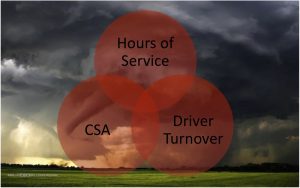 If you thought it was difficult to find good drivers before the 2020 pandemic, try finding drivers of any caliber afterwards. Driver shortages have become even more of a reality in the supply chain industry for a number of reasons, chief among them being the sharp rise in demand.
If you thought it was difficult to find good drivers before the 2020 pandemic, try finding drivers of any caliber afterwards. Driver shortages have become even more of a reality in the supply chain industry for a number of reasons, chief among them being the sharp rise in demand.
The pandemic taught consumers that the most convenient and safest way to “get that thing” is to order it online and have it delivered, increasing not only the demand for qualified drivers but also the cost to hire.
As driver pay increases, so does the incidence of drivers jumping ship, switching companies for the next best payday. According to CNN Business, the annual turnover rate for drivers hit 95% most recently, and that’s without considering the negative pressure higher pay puts on the willingness to endure four out of five weeks on the road.
Throw in regulations regarding medical testing, licensing qualifications and safety enforcement, and it’s not difficult to see – something’s got to give. Could the obvious solution be that curious notion of driverless vehicles?
The Curious Case of the Headless Driver
Make no mistake, driverless vehicles are here to stay, driver shortage or not. Currently, most driverless opportunities are limited to secure private zones or closed environments, such as warehouses, campus environments or last mile runs from depot to front door. But the industry is watching as the technology opens new opportunities for safety, savings and speed long-haul, raising curiosity on the strength of a compelling business case.
For starters, many of the rules that apply to human drivers do not apply to driver robots. For instance, a bot never needs to take a mandatory break after 10 hours on the road or pass a drug test. And, while Federal Motor Carrier Safety Administration (FMCSA) Regulations for driverless vehicles are still emerging, the general code was not made for driverless vehicles; it was meant for human driver safety.
What’s more, bots don’t require paychecks, benefits, vacations, training or other workforce overhead. Deploying driverless vehicles could take a significant bite out of operating costs, considering that approximately 75% of company expenses are tied up in labor. There will still be a workforce needed to maintain those driverless vehicles or costs associated with maintenance done by the manufacturer or a 3rd party.
To demonstrate, one California autonomous vehicle company, TuSimple, tested the efficacy of long-haul driverless vehicles in a recent trek from Nogales, Arizona to Oklahoma City, shaving 10 hours (42%) off of what would otherwise be a 24-hour trip. The journey was bracketed with a human driver handling pick-up and delivery of the shipment, while an automated driver took the long-haul segment in between.
An impressive case study to be sure, but alas, the cost of the technology is still prohibitive for most companies. A January 2021 DOT report suggests that “only 48% of trucking firms would be able to buy the technology in the decade after it becomes available.” Approval of long-haul driverless technology isn’t projected to settle until around 2031.
Curiouser and Curiouser
For as curious as many are over the potential of driverless vehicles, logistics companies need to get even curiouser about what’s driving their bottom lines. There are many ways to address the driver shortage, but perhaps none is more powerful or effective than knowing what’s going on in your business.
In a word, it’s data. Capturing it, cleaning it, screening it and analyzing it to determine better routes, better prices, and better sources is foundational to smart logistics operations. State-of-the-art warehouse, labor and transportation management systems are designed to facilitate the kind of real-time data analysis necessary for spotting cost-saving, productivity-enhancing, margin-building opportunities. In fact, using modern AI and machine learning tools to track market movements, you can perfect your game as you also improve your ability to predict future market fluctuations and plan proactively.
One way to gain an edge is to analyze existing carrier contracts against spot market pricing posted on load boards and freight auctions to determine if your current carriers are in line with going rates. In a tight market, it never hurts to shop your contracts. Perhaps you signed deals years ago at a high rate that now stands below market due to rising demand. Perhaps you’re overpaying. Perhaps one carrier deserves more of your business than another. Knowing the details will equip you to either negotiate or hold tight based on facts.
Tender rejection rates are another stat to examine. If you’re tendering out loads and see a rise in rejections, from say 2%, which is pretty good, to suddenly 10%, you likely need to examine your rates for particular lanes. Configure your system dashboard to watch the spot market and time your moves to optimize bids by lanes, carriers and time slots.
Good data will help you track valuable decision factors such as best per-mile rates, conditional charges, field charges and other variables to ensure your best bang for the buck. You can also build metrics to support your hiring practices, making sure you’re paying drivers what they’re worth to inhibit churn, enhance acceptance rates or stem the tide of driver turnover.
Keep Your Eyes on the Road
There are many ways existing, modern technology can help you effectively manage changing market conditions, such as driver shortages, without lurching prematurely into the future. Certainly, keep an eye on the horizon. But also, do yourself a favor by getting curious about what’s really driving your business. Know what’s happening, gauge its impact on your business, carefully examine where to make adjustments and get better at it over time. By analyzing data, monitoring KPIs and making decisions based on facts, you can better predict the market and plan for better business outcomes.
 Byron Davis, Senior Director, Client Services, Open Sky Group. As a Senior Director at Open Sky Group, Byron’s focus is building and growing the Transportation Management practice. Open Sky Group’s mission is to deliver technology-enabled solutions that allow our customers to achieve more, often with less, while having the flexibility to adapt to change. Our mission and core values are the foundation of our culture and guiding source in our interactions. Byron lives the core values and mission each day by bringing the best experience possible to our clients. Not only does he provide internal support to our Sales and Marketing team through presentations and industry interviews, Byron works alongside our TMS teams and clients, encouraging them to use innovation and best practices instead of customizations for their long-term success.
Byron Davis, Senior Director, Client Services, Open Sky Group. As a Senior Director at Open Sky Group, Byron’s focus is building and growing the Transportation Management practice. Open Sky Group’s mission is to deliver technology-enabled solutions that allow our customers to achieve more, often with less, while having the flexibility to adapt to change. Our mission and core values are the foundation of our culture and guiding source in our interactions. Byron lives the core values and mission each day by bringing the best experience possible to our clients. Not only does he provide internal support to our Sales and Marketing team through presentations and industry interviews, Byron works alongside our TMS teams and clients, encouraging them to use innovation and best practices instead of customizations for their long-term success.
Open Sky Group, global specialists in the Blue Yonder supply chain platform (formerly JDA RedPrairie Software), helps companies like yours implement and upgrade warehouse, labor and transportation management systems. To learn more, visit https://www.openskygroup.com


















